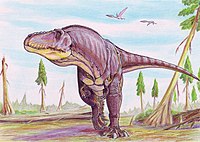1955 in paleontology
| |||
|---|---|---|---|
|
Paleontology or palaeontology is the study of prehistoric life forms on Earth through the examination of plant and animal fossils.[1] This includes the study of body fossils, tracks (ichnites), burrows, cast-off parts, fossilised feces (coprolites), palynomorphs and chemical residues. Because humans have encountered fossils for millennia, paleontology has a long history both before and after becoming formalized as a science. This article records significant discoveries and events related to paleontology that occurred or were published in the year 1955.
Plants[]
Pteridophyta[]
| Name | Novelty | Status | Authors | Age | Type locality | Location | Notes | Images |
|---|---|---|---|---|---|---|---|---|
|
Comb nov |
Valid |
A waterfern, moved from Azollophyllum primaevum Penhallow, 1890 |
Dinosaurs[]
- Massospondylus gastroliths are documented.[3]
Newly named dinosaurs[]
Data courtesy of George Olshevsky's dinosaur genera list.[4]
| Name | Status | Authors | Age | Unit | Location | Notes | Images | ||
|---|---|---|---|---|---|---|---|---|---|
| Majungasaurus[5] | Valid taxon |
Late Cretaceous (Maastrichtian) |
A majungasaurine abelisaurid. |
||||||
| Tarbosaurus[6] | Valid taxon |
Late Cretaceous (late Campanian-early Maastrichtian) |
|
An Asian Tyrannosaurus-looking tyrannosaurid. |
|||||
Synapsids[]
Theriodonts[]
| Name | Status | Authors | Age | Unit | Location | Notes | Images |
|---|---|---|---|---|---|---|---|
|
Valid |
Bystrow |
Semen Formation |
A gorgonopsian. |
||||
|
Valid |
Crompton and Parrington |
Middle Triassic |
A traversodontid cynodont. |
Eutherians[]
Cetaceans[]
| Name | Status | Authors | Age | Unit | Location | Notes | Images |
|---|---|---|---|---|---|---|---|
|
Kellogg |
Middle Miocene (Langhian) |
Synonim of . |
|||||
|
|
Valid |
Kellogg |
Middle Miocene (Langhian) |
An odontocete of uncertain position. |
|||
|
|
Valid |
Kellogg |
Middle Miocene (Langhian) |
|
An odontocete of uncertain position; new genus for "Delphinapterus" gabbi Cope (1868). |
References[]
- ^ Gini-Newman, Garfield; Graham, Elizabeth (2001). Echoes from the past: world history to the 16th century. Toronto: McGraw-Hill Ryerson Ltd. ISBN 9780070887398. OCLC 46769716.
- ^ Arnold, C.A. (1955). "A Tertiary Azolla from British Columbia" (PDF). Contributions from the Museum of. Paleontology, University of Michigan. 12 (4): 37–45.
- ^ Bond (1955). Sanders, Manley, and Carpenter (2001), "Table 12.1" page 167.
- ^ Olshevsky, George. "Dinogeorge's Dinosaur Genera List". Retrieved 2008-08-07.
- ^ Lavocat, R. 1955. Sur une portion de mandibule de thérepode provenant de Crétace supérieur de Madagascar. Bull. Musee Natl. d’Histoire Nat. (ser. 2) 27: pp. 256-259.
- ^ Maleev, E. A. (1955). "Гигантских плотоядных динозавров Монголии" [Gigantic carnivorous dinosaurs of Mongolia]. Doklady Akademii Nauk SSSR. 104: 634–637.
- Bond, G. 1955. A note on dinosaur remains from the Forest Sandstone (Upper Karoo). Occasional Papers of the National Museum of Rhodesia 2: 795–800.
- Sanders F, Manley K, Carpenter K. Gastroliths from the Lower Cretaceous sauropod Cedarosaurus weiskopfae. In: Tanke D.H, Carpenter K, editors. Mesozoic vertebrate life: new research inspired by the paleontology of Philip J. Currie. Indiana University Press; Bloomington, IN: 2001. pp. 166–180.
- 1955 in paleontology
- 1950s in paleontology
- 1955
- 1955 in science



